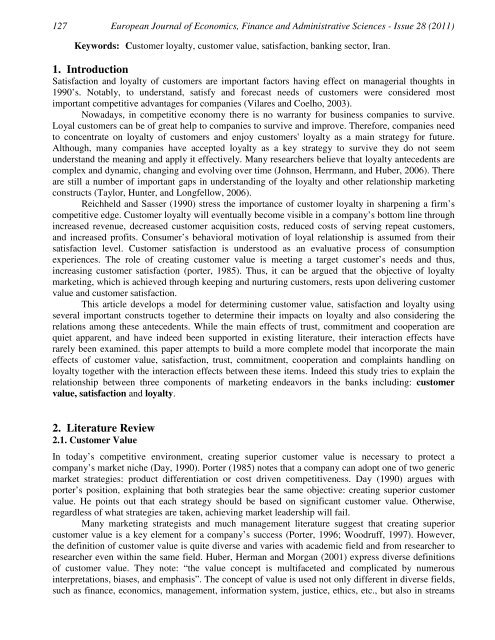Designing a New Model for Determining Customer ... - EuroJournals
Designing a New Model for Determining Customer ... - EuroJournals
Designing a New Model for Determining Customer ... - EuroJournals
Create successful ePaper yourself
Turn your PDF publications into a flip-book with our unique Google optimized e-Paper software.
127 European Journal of Economics, Finance and Administrative Sciences - Issue 28 (2011)<br />
Keywords: <strong>Customer</strong> loyalty, customer value, satisfaction, banking sector, Iran.<br />
1. Introduction<br />
Satisfaction and loyalty of customers are important factors having effect on managerial thoughts in<br />
1990’s. Notably, to understand, satisfy and <strong>for</strong>ecast needs of customers were considered most<br />
important competitive advantages <strong>for</strong> companies (Vilares and Coelho, 2003).<br />
Nowadays, in competitive economy there is no warranty <strong>for</strong> business companies to survive.<br />
Loyal customers can be of great help to companies to survive and improve. There<strong>for</strong>e, companies need<br />
to concentrate on loyalty of customers and enjoy customers' loyalty as a main strategy <strong>for</strong> future.<br />
Although, many companies have accepted loyalty as a key strategy to survive they do not seem<br />
understand the meaning and apply it effectively. Many researchers believe that loyalty antecedents are<br />
complex and dynamic, changing and evolving over time (Johnson, Herrmann, and Huber, 2006). There<br />
are still a number of important gaps in understanding of the loyalty and other relationship marketing<br />
constructs (Taylor, Hunter, and Longfellow, 2006).<br />
Reichheld and Sasser (1990) stress the importance of customer loyalty in sharpening a firm’s<br />
competitive edge. <strong>Customer</strong> loyalty will eventually become visible in a company’s bottom line through<br />
increased revenue, decreased customer acquisition costs, reduced costs of serving repeat customers,<br />
and increased profits. Consumer’s behavioral motivation of loyal relationship is assumed from their<br />
satisfaction level. <strong>Customer</strong> satisfaction is understood as an evaluative process of consumption<br />
experiences. The role of creating customer value is meeting a target customer’s needs and thus,<br />
increasing customer satisfaction (porter, 1985). Thus, it can be argued that the objective of loyalty<br />
marketing, which is achieved through keeping and nurturing customers, rests upon delivering customer<br />
value and customer satisfaction.<br />
This article develops a model <strong>for</strong> determining customer value, satisfaction and loyalty using<br />
several important constructs together to determine their impacts on loyalty and also considering the<br />
relations among these antecedents. While the main effects of trust, commitment and cooperation are<br />
quiet apparent, and have indeed been supported in existing literature, their interaction effects have<br />
rarely been examined. this paper attempts to build a more complete model that incorporate the main<br />
effects of customer value, satisfaction, trust, commitment, cooperation and complaints handling on<br />
loyalty together with the interaction effects between these items. Indeed this study tries to explain the<br />
relationship between three components of marketing endeavors in the banks including: customer<br />
value, satisfaction and loyalty.<br />
2. Literature Review<br />
2.1. <strong>Customer</strong> Value<br />
In today’s competitive environment, creating superior customer value is necessary to protect a<br />
company’s market niche (Day, 1990). Porter (1985) notes that a company can adopt one of two generic<br />
market strategies: product differentiation or cost driven competitiveness. Day (1990) argues with<br />
porter’s position, explaining that both strategies bear the same objective: creating superior customer<br />
value. He points out that each strategy should be based on significant customer value. Otherwise,<br />
regardless of what strategies are taken, achieving market leadership will fail.<br />
Many marketing strategists and much management literature suggest that creating superior<br />
customer value is a key element <strong>for</strong> a company’s success (Porter, 1996; Woodruff, 1997). However,<br />
the definition of customer value is quite diverse and varies with academic field and from researcher to<br />
researcher even within the same field. Huber, Herman and Morgan (2001) express diverse definitions<br />
of customer value. They note: “the value concept is multifaceted and complicated by numerous<br />
interpretations, biases, and emphasis”. The concept of value is used not only different in diverse fields,<br />
such as finance, economics, management, in<strong>for</strong>mation system, justice, ethics, etc., but also in streams

















